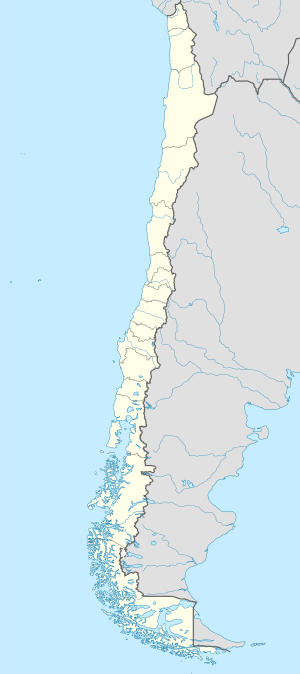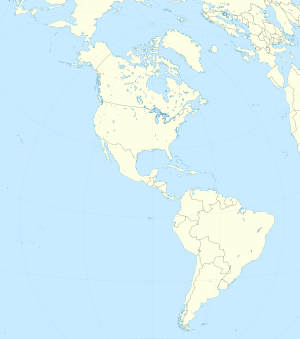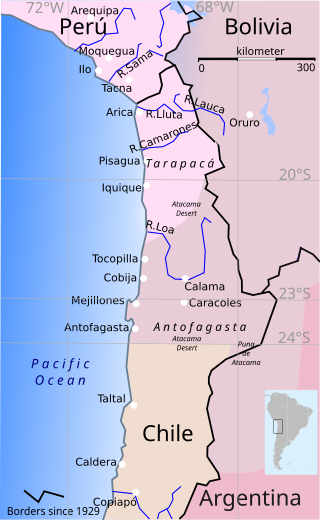
The War of the Pacific, also known by multiple other names, was a war between Chile and a Bolivian–Peruvian alliance from 1879 to 1884. Fought over Chilean claims on coastal Bolivian territory in the Atacama Desert, the war ended with victory for Chile, which gained a significant amount of resource-rich territory from Peru and Bolivia.
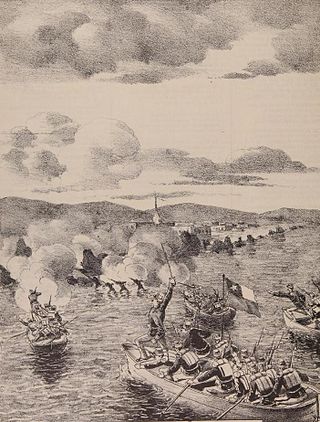
The Battle of Pisagua, was a landing operation of the War of the Pacific, fought on November 2, 1879, between Chile and the combined forces of Bolivia and Peru. The Chilean army commanded by Erasmo Escala, supported by the Chilean Fleet, launched an amphibious assault on the port of Pisagua and successfully drove the defending Bolivian-Peruvian forces, led by Gen. Juan Buendia, back from the shore. They established a beachhead that allowed an initial force of about 1,000 Chilean soldiers in two assault waves to disembark onto Peruvian territory at Pisagua in Tarapacá Department. This region was the principal territory in dispute.

The Battle of San Francisco, also known as the Battle of Dolores, was a major battle in the Tarapacá Campaign of the War of the Pacific, fought on November 19, 1879, in the Peruvian department of Tarapacá. A Chilean army under Colonel Emilio Sotomayor had moved via Dolores rail road deep into the desert and was encamped at San Francisco Saltpeter Office, about 30 kilometers south east of the port of Pisagua. Allied forces under General Juan Buendía launched an attack on Sotomayor's army. At the beginning, Bolivian General Carlos de Villegas pressed the attack over a poorly defended battery right in the Chilean centre and almost succeeded. Only the arrival of infantry support allowed Colonel José Domingo Amunátegui to hold the position.

The Battle of Tarapacá occurred on 27 November 1879 during the Tarapacá Campaign of the War of the Pacific. Three Chilean columns of almost 3,900 soldiers attacked a numerically inferior Peruvian contingent of 3,046 troops at Tarapacá - 500 of which were at Quillahuasa, 1 hour away from the battlefield - commanded by Gen Juan Buendía, resulting in a harsh defeat. The Chilean 2nd Line Regiment was the most damaged unit, losing almost half of its force, along with its commander Col. Eleuterio Ramírez and his second in command, Lt. Col. Bartolomé Vivar. The unit lost its banner, which was recovered six months later after the Battle of Tacna. Despite the victory, the Allies could not contest for the domination of the Tarapacá department, abandoning it to Chilean control.

Hilarión Daza was a Bolivian military officer who served as the 19th president of Bolivia from 1876 to 1879. During his presidency, the infamous War of the Pacific started, a conflict which proved to be devastating for Bolivia.
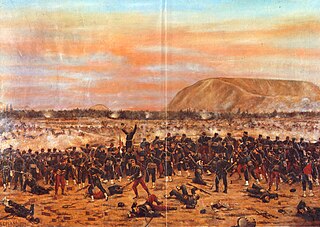
The Battle of Miraflores occurred on January 15, 1881 in the Miraflores District of Lima, Peru. It was an important battle during the War of the Pacific that was fought between Chile and the forces of Peru. The Chilean army led by Gen. Manuel Baquedano defeated the army commanded by Nicolás de Piérola guarding the second defensive line of the Peruvian capital city. Two days later, Lima, the capital city of Peru was occupied by Chilean troops. Gen. Baquedano's forces marched into Lima triumphant, while Peru's president and his officers fled into the interior, leaving the country without any government. Even after the fall of Lima, the war continued between the occupation army and the troops of Andres Caceres for another three years. During the occupation of Lima, Peru's National Library was burned, while a number of other monuments were ransacked by Chilean forces and taken as war trophies.

The Battle of San Juan, also known as the Battle of San Juan and Chorrillos, was the first of two battles in the Lima Campaign during the War of the Pacific, and was fought on 13 January 1881. This battle is really a group of smaller, yet fierce confrontations at the defensive strongholds of Villa, Chorrillos, Santiago de Surco, San Juan de Miraflores, Santa Teresa and Morro Solar. The Chilean army led by Gen. Manuel Baquedano inflicted a harsh defeat on the Peruvian army commanded by the Supreme Chief Nicolás de Piérola. The Chilean triumph eliminated the first defensive line guarding Lima, and almost obliterated the Peruvian army defending it.

The Battle of Tacna, also known as the Battle of the Peak of the Alliance, effectively destroyed the Peru-Bolivian alliance against Chile, forged by a secret treaty signed in 1873. On 26 May 1880, the Chilean Northern Operations Army led by General Manuel Baquedano González, conclusively defeated the combined armies of Peru and Bolivia commanded by Bolivian President, General Narciso Campero. The battle took place at the Inti Urqu (Intiorko) hill plateau, a few miles north of the Peruvian city of Tacna. As a result, Bolivia was knocked out of the war, leaving Peru to fight the rest of the war alone. Also, this victory consolidated the Chilean domain over the Tarapacá Department. The territory was definitively annexed to Chile after the signing of the Tratado de Ancón, in 1884, which ended the war. Tacna itself remained under Chilean control until 1929.

The Tarapacá campaign was a short stage of the War of the Pacific in the last months of 1879, after the Chileans won definitive naval superiority at Angamos. It took its name from the region where it was fought.
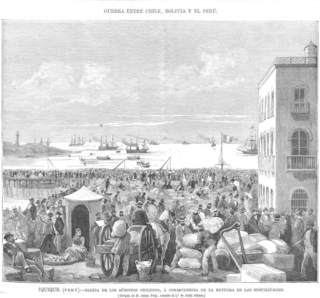
The Expulsion of Chileans from Bolivia and Peru in 1879 was an ethnic cleansing ordered by of the governments of Bolivia and Peru. The expulsion took place at the beginning of the War of the Pacific (1879–1883) between Chile and Peruvian-Bolivian alliance. Chilean citizens in both nations were ordered to leave within eight days or face internment and confiscation of their property. They were expelled on poorly built rafts and pontoons at Peruvian ports, or forced to wander through the desert to reach the northernmost positions occupied by the Chilean Army in Antofagasta. The edict was widely popular in Peru and met with little resistance, allowing it to occur quickly.

The Lima campaign is the third land campaign of the War of the Pacific, carried out by Chile between December 1880 and January 1881. The campaign ended with the Chilean occupation of the Peruvian capital and the establishment of the Chilean authority in it and other surrounding territories, which would extend until 1883, with the end of the war.

Sofanor Parra Hermosilla, was a Chilean military officer who served in the Chilean Army, in the cavalry branch, and who reached the rank of divisional general.

The Bombardment of Pisagua, was an act of arms by Chile on Peru that took place on April 18, 1879, within the framework of the naval operations developed during the War of the Pacific. The first civilian casualties of the war were produced there.

The Battle of Tambillo was a battle of the War of the Pacific that occurred on December 6, 1879, between the Bolivian 5th Division under the command of Colonel Rufino Carrasco and the Chilean garrison stationed at the town commanded by Lieutenant Emilio Ferreira.

Manuel Belisario Suárez y Vargas (1833–1910) was a Peruvian colonel and politician that was notable for serving in several battles of the War of the Pacific as well as holding several offices within the Congress of the Republic of Peru.

The Battle of Pampa Germania was a cavalry battle of the Tarapacá campaign of the War of the Pacific that took place on November 6, 1879. In this battle, the Chilean cavalry led by Lieutenant Colonel José Francisco Vergara and Sofanor Parra ambush and massacre the allied cavalry commanded by Peruvian Lieutenant Colonel José Buenaventura Sepúlveda who was in the rear of the allied army, which had already undertaken their march to Dolores, in the Pampa Germania sector, near Agua Santa.
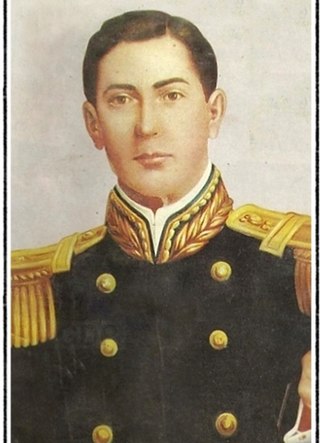
José Buenaventura Sepulveda Fernández was a Peruvian Lieutenant Colonel that served the War of the Pacific and was notable for his service at the Battle of Pampa Germania, in which he was killed at the aforementioned battle.

Pedro José Sevilla Yturralde was a Peruvian colonel who was the head of the 3rd Cazadores del Rímac Regiment, as well as one of the main commanders of the Battle of El Manzano of the Lima campaign during the War of the Pacific before being captured and imprisoned in Chile for the remainder of the war.
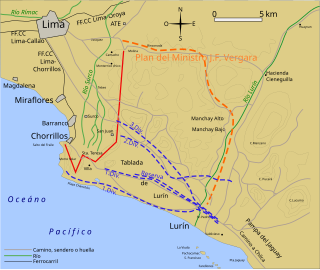
The Battle of El Manzano, also known as the Battle of Pachacamac was a confrontation between Peruvian and Chilean forces that occurred on December 27, 1880 in the El Manzano hills on the south side of the Lurín River during the Lima campaign during the War of the Pacific.

The Hussars of Junín, officially the Cavalry Regiment "Glorious Hussars of Junín" № 1 Liberator of Peru, is a traditional light cavalry regiment of the Peruvian Army. Originally the 4th Squadron of the Peruvian Guard Legion, the unit was renamed in 1824 to its current name after its performance in the Battle of Junín.

